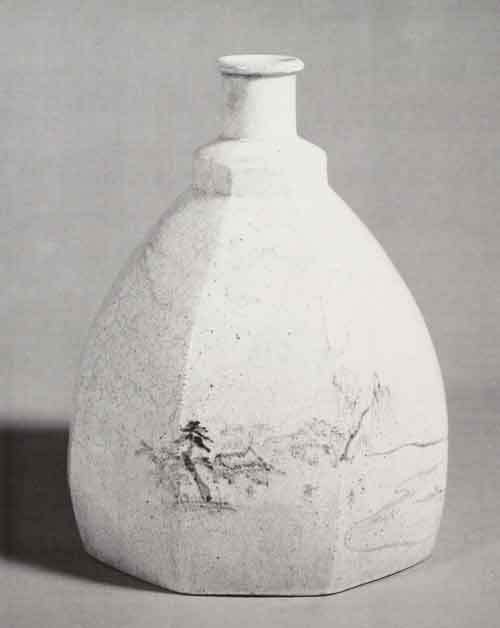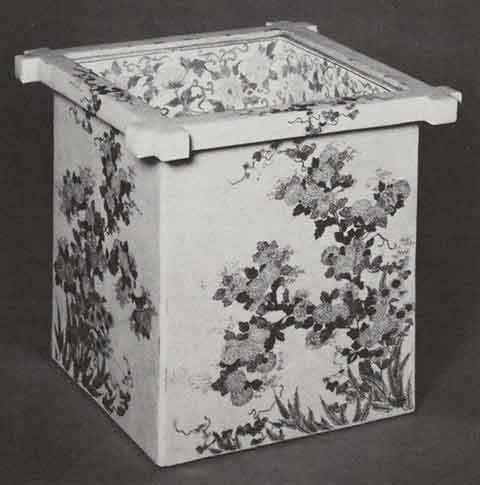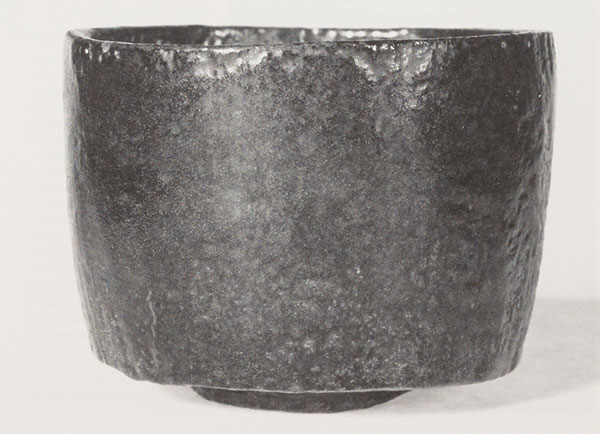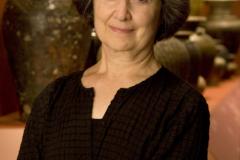Japanese Ceramics in America: the Early Years
For the most part, our images of Japanese ceramics arise from books that have been published, collections that have been formed, and exhibitions that have been held in the years since 1940, when the first edition of Bernard Leach's A Potter's Book introduced Raku tea bowls by Koetsu and Kenzen and teapots by Hamada. We know the Shino, Karatsu and Bizen wares made by "Living National Treasures" and the Momoyama period (1568-1615) originals that inspired them. We recognize lmari, Kakiemon, and Kutani styles of decorated porcelain. We have a certain sense of color, texture, form, and cultural setting that seems to refleet the "truth" about ceramics in Japan.

Collecting Japanese ceramics was a central element of the movement known as Japonisme that was underway in Europe and the United States by the 1870s. Some American collectors went to Japan to shop, but Japanese dealers also opened galleries in major cities on both coasts. Although many of those early collections were dispersed, some found permanent homes in museums including the Boston Museum of Fine Arts, the Metropolitan Museum of Art in New York, the George Walter Vincent Smith Museum in Springfield, Massachusetts, the Walters Art Gallery in Baltimore, and the Freer Gallery of Art in Washington, D.C. A look at those museum collections reveals that collectors at the turn of the last century operated with very different assumptions about what constituted quality and value in Japanese ceramics.
Notably, age that it is today, when many Japanese dealers and American collectors operate on the “Momoyama or nothing” principle that focuses on wares of that period (1568-1615) to the exclusion of almost all others, especially works from the nineteenth century. Then, many collectors confidently shopped at the expositions for pieces by living studio potters. Similarly, when they bought old pieces from dealers, age was usually subordinate to form, color, and decoration as a deciding factor in the purchase.
Indeed, the distinction between expositions and dealers was to as clear cut as that between a department store and a gallery today. Japanese studio potters such a Miyazawa Kozan and Itaya Hazan viewed expositions as appropriate places to present their work, and fine examples are now in the Walters Art Gallery and the George Walter Vincent Smith Museum.2 At the major expositions, antique Japanese ceramics and modern studio pieces supplie by reputable dealers alongside wares from Kyoto, Set, and Yokohama workshops promoted by Japanese local and prefectural governments. The dealers were not above appealing to popular taste as well. Mitsuki Bunko, who had a gallery in Boston and supplied influential collectors including Charles Freer, also operated a “Japan corner” in the major department store in Salem, Massachusetts. He imported a rickshaw in which the female shop attendants, dressed in Japanese costume, were pulled through the streets of the city as advertisement.
Japanese potters, too, were in the process of redefining their roles. Until 1868 pottery-making was largely a hereditary occupation. Many potters worked under daimyo sponsorship, producing elaborate and technically refined pieces for private use in gift exchanges. With the change in government, such workshops lost their protected status and their work its original meaning. The urban wholesale is who became the new financiers for the ceramic industry capitalized on established reputations by turning the names of the domains (such as Hirado) or the crests of the former patrons (the blue cross within a circle found on Satsuma wares) into commercial trademarks. Fortunately, the ornate wares made to daimyo taste appealed to foreigners as well, with the result that many such workshops developed in the direction of even more virtuoso products featuring impossibly miniscule carved openwork or minutely-painted overglaze enamel decoration.
Other workshops capitalized on Euro-American fascination with unfamiliar aspects of Japanese life (also manifest in the popularity, among visitors to Japan, of studio photographs staging genre scenes) to make "cherry blossoms, Mt. Fuji, and geisha" the subject of decor on tea sets and chocolate pots. With decoration rather than shape the dominant source of appeal, independent workshops sprang up to apply enamels to blanks bought from established ceramics centers. The 1876 Philadelphia exhibition featured "flower vases made at Owari and Hizen and decorated at Tokio."3

This was also the time when some of the first self-defined potters emerged to take up the role by choice rather than accident of birth. Some were out-of-work samurai who saw an opportunity for a new occupation; others, such as ltaya Hazan (whose father was a small-town soy-sauce manufacturer) entered the field through studies at newly-established Western-style art schools.
In short, the late nineteenth century was a time when categories of Japanese ceramics were not fixed. Japanese potters were redefining their positions. American and European patrons were groping toward definitions of quality and trying to sort out the differences among ethnographic specimens, pieces aimed at the foreign market, and objets d'art.
This confusion among consumers found its epitome in a fierce battle waged in print in the 1890s between two prominent collectors, James Lord Bowes and Edward Sylvester Morse, over who had the correct perception of "true" Japanese taste in ceramics. The Englishman Bowes championed the technical and aesthetic progressiveness of the finely decorated products of Satsuma, Kutani, and Kyoto. Railing against the "rude and undecorated pottery of the middle ages” that had "exercised a strange and unaccountable fascination upon the native mind," he condemned the appreciation of dark-glazed, asymmetrical ceramics within the context of tea drinking (chanoyu). The American Morse, who during his years of residence in Japan had formed the famous collections now in the Boston Museum of Fine Arts and the Peabody Museum in Salem, Massachusetts, and had gained familiarity with Japanese culture, claimed that ordinary domestic pottery and tea ceramics most truly reflected Japanese taste.4
Although Bowes and Morse each spoke adamantly for a competing "true definition" of Japanese ceramics - and Morse was a powerful influence particularly upon American collectors - most surviving American collections
formed in that era actually contain an eclectic sampling of "the Undecorated, the Decorated, and the Modern," as Bowes defined the major types, and they include in the "Undecorated" category both tea wares and popular domestic wares.
The collection formed by Charles Lang Freer (1854-1919) between 1892 and 1917 is representative of those types. Of the approximately nine hundred Japanese ceramics now in the Freer Gallery of Art collection at the Smithsonian Institution in Washington, D.C., over six hundred were acquired by Freer himself.5 He made his earliest purchases in New York, but by 1896 he had begun buying from Matsuki Bunkyo and from Yamanaka and Company, first from its New York branch and later from the parent company in Japan, and they became his major sources. Many pieces were secured during lengthy trips to Japan in 1895, 1907, and 1911. From then onward, although he continued to make sporadic purchases of Japanese pieces, his interest (partly directed by a sharp rise in the prices of Japanese antiques) shifted to Korean, Chinese and Near Eastern ceramics.

In 1907, having completed negotiations to give his growing collection of Asian art to the United States and to establish the first art museum within the Smithsonian Institution, Freer invited Morse to examine and appraise his Japanese ceramics. (Subsequently, on the basis of Morse's advice and his own taste, he donated pieces to several university art museums, including those at Amherst College and Oberlin College.) Freer's notes show he accepted Morse's attributions for most pieces, even when they overthrew identifications supplied by Japanese dealers.
With hindsight it is possible to say that Freer was not unreasonable to trust Morse in many cases. Freer's collection includes many pieces whose identifications, supplied by the dealers who sold them, represent sheer ignorance of a body of connoisseurship that had been built up during the Edo period (1615-1868) and then lost as social roles were reshuffled during the ensuing Meiji period (1868-1912). For example, tea leaf storage jars that would have been staples in daimyo collections, and that any cultivated Edo-period Japanese would have been able to identify instantly as Chinese, were represented to Freer as being Japanese.
When looking at Freer's collection or other similar groups of Japanese ceramics - even Morse’s - with the benefit of almost a century more of scholarly research, archaeology, exhibitions, and publications, it is easy to feel smug about the limitations or failings of those early collectors. Yet they reflect a fascination with a new-found but ancient culture and an enthusiastic effort to make sense of it through attention to one particularly attractive aspect. Less knowledgeable than we are about Japanese ceramics (and culture), they were also in some senses less bound by stereotypes. They have left us collections rich in diversity and welcome surprises.

